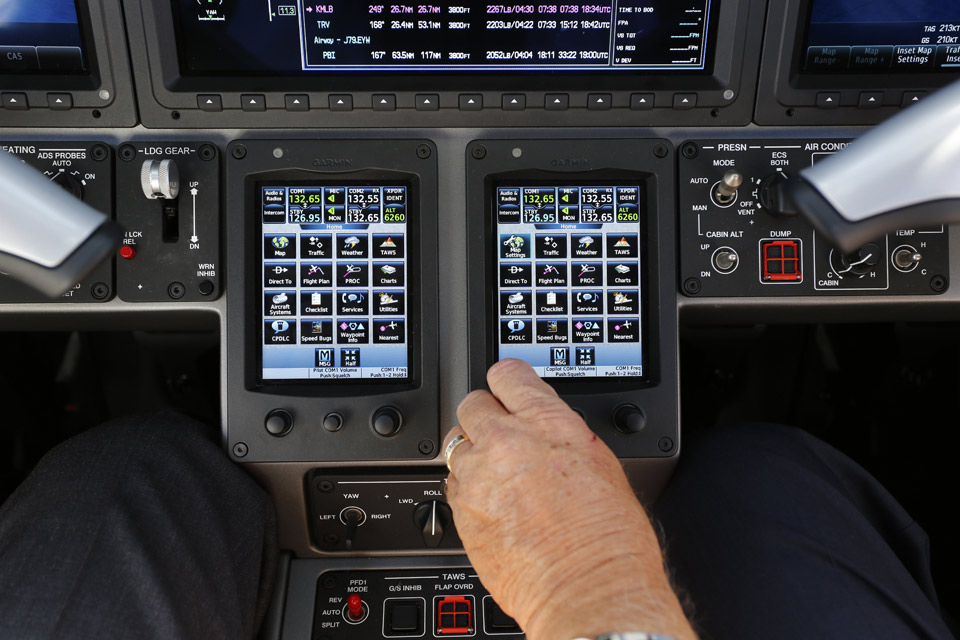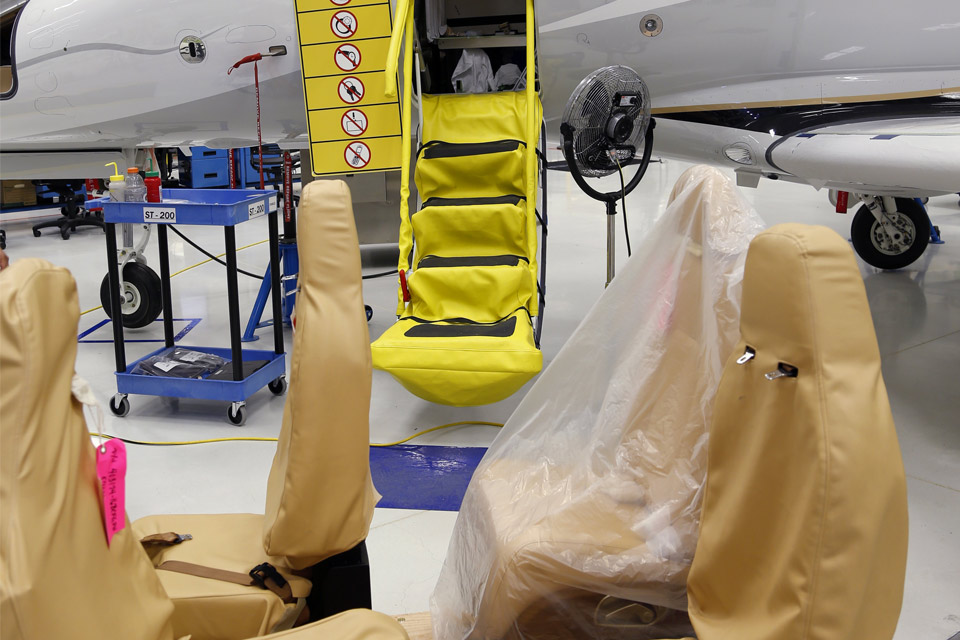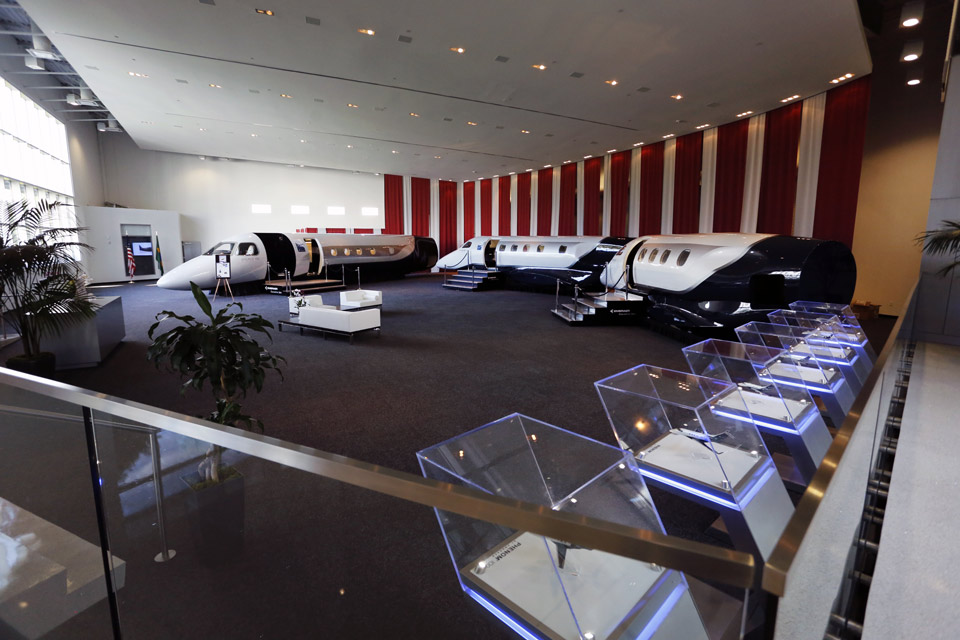The recession has taken its toll on all business jet manufacturers, but Brazil’s Embraer appears to have felt its sting the least. For example, since the first Phenom 100s began delivery in December 2008, more than 300 of the 390-knot, 1,178-nm six-seaters have been sold—with 30 of them in 2013. And sales of the Phenom 100’s big brother, the Phenom 300, have recently topped the 200 mark. It’s worth noting that the 200th Phenom 300 was sold to fractional operator NetJets as part of a firm order for 50 additional 300s, plus options for another 75. That translates into $1 billion in sales if all those options are converted into sales. And in 2013 alone, the Phenom 300 was the best-selling “light” jet (if you consider its 17,968-pound max takeoff weight as light) of all, with 60 deliveries.
Compare these numbers with those of what many consider to be the Phenom 100’s closest competitors. Cessna delivered 20 of its Mustangs in 2013, and just three in the first two quarters of 2014, according to the General Aviation Manufacturers Association (GAMA). In the same period, a total of 31 Citation M2s have been delivered. The Phenom 300’s principal competitor—the Citation CJ4—turned in 33 sales in 2013 and 12 in the first two quarters of 2014.
So first things first: The Phenoms are a pleasure to fly, sophisticated yet simple to operate, economically competitive, with ever-innovative and roomy interior designs and an exemplary service network and philosophy. That helps explain their success. The fact that they’ve made a significant investment in a final assembly facility in Melbourne, Florida, doesn’t hurt either.
Another reason for the Phenoms’ strong sales is a series of improvements over the past few years. AOPA Pilot recently visited Embraer’s new assembly, engineering, and design facility in Melbourne, Florida, to have a firsthand look at the latest versions of the Phenoms 100 and 300.
Phenom 100E
The 201th Phenom 100 carried the “E” (for enhanced and efficient) suffix in order to highlight a new feature in its standard equipment list: multifunction spoilers. Activated by a two-position toggle switch on the center console, these are inboard panels on the wing trailing edges used for reducing airspeed and increasing descent rates. After landing, the same panels deploy automatically to put more weight on the wheels, increase brake effectiveness, and produce shorter landing distances.
There’s a good reason why Embraer added spoilers. The Phenom is slippery, and before the 100E it had no spoilers. Moreover, its 1,695-pound static thrust (lbst) Pratt & Whitney PW617 engines have no reverse thrust. This adds up to a requirement for precise airspeed control on approach. At the Embraer/CAE Phenom training facility at Dallas-Fort Worth International Airport, trainees are taught to cross the final approach fix fully configured for landing, and to fly down the final approach course at VREF. This is 91 to 105 knots, depending on weight. Any faster, and the airplane could float far down the runway.
Of course, the Phenoms have powerful brake-by-wire systems to minimize stopping distances, but the initial brake systems proved troublesome to some. They were too powerful, others said, and had little in the way of progressive control feel or feedback through the pedals. For many, the experience was the sensation of either full braking or none at all. This led pilots to try to modulate braking by pumping them, which could—and did—lead to swerving, as well as longer landing distances.
A spate of landing accidents were attributed to pilots flying too high and/or too fast on final. In one especially dramatic May 2011 accident, a Phenom 100 ran off the end of the runway at Sedona, Arizona, then went 200 to 300 feet down an embankment; resulting in minor injuries to the five aboard. In a February 2013 runway excursion after a landing at Berlin’s Schoenefeld Airport, a Phenom 100’s landing gear collapsed but all three aboard were uninjured. In two other cases, both main landing gear tires blew after pilots landed without brakes and stopped using the very powerful, yet sensitive, emergency braking system—which also serves as a parking brake. The landings were preceded by “Brake Fail” annunciations.
So the spoilers, and progressive improvements to the braking system, were Embraer’s answer to these issues. Currently, Phenom 100s are on their ninth brake control unit (BCU) upgrade. The upgrades are provided by Embraer free of charge.
My flight in N531EE, Embraer’s P100E demonstrator, gave me the chance to experience the new features firsthand. Thanks to a simple, well-designed panel, Embraer’s Prodigy flight deck (based on Garmin’s G1000 avionics suite), automated systems, and full authority digital engine controls (FADEC) starting is a breeze—rotate the start switches to the Start position, and wait for lightoff. Any anomalies? Then the FADEC will shut the engine(s) down.
Taxiing was easier than I recall in earlier Phenom 100s. Embraer made newer rudder springs, pedal pivot design changes, and other software modifications to help tone down the brakes’ grabbiness. The trick, I was told, is to keep your heels on the bottom of the pedals and steer with the nosewheel as much as possible. The temptation is to fall back on old habits and steer relying on differential braking. You want to keep that to a minimum to avoid those jerky steering responses by the BCUs.
Then it was power to the TO detent, a short wait for the V1 and VR of 91 knots, and off we went in a 2,000-fpm climb to altitude. Once level at FL340, it was time to sample yet another, much-anticipated upgrade. The Prodigy avionics’ latest software (“load 63,” I was told) includes the ability to hold at any fix or position. Before, the autoflight system would only execute holding patterns associated with missed approaches. Now it’s a matter of highlighting any fix or location, hitting the “menu” button, then entering the inbound course, direction of turns, leg length or time, and pressing the Enter key. Now the airplane will automatically fly the holding pattern. Before, you had to manually fly around a holding pattern using the heading bug.
Leaving the hold, it was time to descend using the spoilers—which do carry some limitations. One is that indicated airspeed must be above 182 knots. Thrust lever angles have to be less than the Max CRZ position, flaps can’t be deployed, and there must be no aural overspeed warnings. European Aviation Safety Agency (EASA) has allowed spoiler use with flaps extended to all but the full down (flaps 4) position, but FAA approval for this is pending.
At idle power I popped the spoilers, set the airspeed at 255 knots, and lowered the nose five degrees below the horizon. There was virtually no aerodynamic “rumble” with the spoilers out, and our descent rate hovered around 4,700 fpm. So attention all Phenom 100 pilots: Are you tired of creeping toward VMO as you’re getting slam-dunked to lower altitudes? Then the 100E solves the problem. The spoilers are available as a retrofit to earlier Phenom 100s. Cost: $300,000 and an extra 110 pounds added to your basic empty weight.
For the landing I flew at a VREF of 98 knots with flaps 4, gear down, and an N1 of approximately 60 percent, with the result being a descent rate of about 600 fpm. Just before the threshold of Runway 9L at Melbourne International Airport I pulled the thrust levers back about half way, then went to idle as we crossed the numbers. I flared ever so slightly, the main gear touched down, followed by the nosewheel, and then I got on the brakes.
I was trying for a nice, smooth braking action and that’s pretty much what I got. I can’t say the braking pedal force was linear, but then again the system is designed to be very businesslike about slowing the plane down, if you get my drift. Welcome to the world of brake-by-wire!
I was careful not to revert to differential brake steering, but old habits didn’t have much of a chance to really kick in. That’s because the multifunction spoilers deployed automatically when they sense weight on wheels, further slowing our landing roll. While this ground spoiler, or lift-dump, function is very effective at increasing the braking force, the airplane receives no FAA “credit” for shorter landing distances. In the airplane flight manual you’ll see the same landing distances as those posted for a non-multifunction-spoiler airplane. Taxiing back to the Embraer ramp was fairly smooth—just remember to steer with your heels as much as possible.
Phenom 300
The front office is the Phenom 300’s big news. Certified late last year, the new, optional Prodigy Touch avionics suite uses two Garmin G3000 touch-screen controllers for data entry, and anyone familiar with Garmin’s GTN 750 or GTN 650 operating methodology will have no problem whatsoever in making peace with these units. Touch the icon representing the functions you want to perform, and an interactive menu appears to customize the entry or view you want.
Along with the controllers come three interchangeable 14.1-inch display screens—two primary flight displays and one multifunction display. Standard screens are slightly smaller, at 12.1 inches. The new, wider screens have 16:9 aspect ratios and much higher, 1280 x 800 ppi (pixels per inch) resolution, and it shows. Non-Touch displays have 800 x 800 ppi resolutions.
In addition, the Prodigy Touch system screens can be set up in a split view that can put two screen views in each screen, for a total of six different views. By the way, the Prodigy Touch suite can be retrofitted to standard-equipped cockpits through a service bulletin; prices vary nation by nation and existing airplane equipage.
The Phenom 300’s BCUs have been updated (they are up to the sixth design change), although I’ve always thought the 300’s brakes had a more conventional feel. One Embraer demonstration pilot put that down to the airplane’s almost 8,000-pound weight difference over the Phenom 100, presumably meaning that brake-by-wire’s sensitivity and effectiveness is a better match for heavier airplanes.
Embraer officials say they are working on a plan to earn FAA approval for a common type rating for both the Phenom 100 and 300. Under the terms of this type rating, a pilot typed in one airplane could earn a type rating in the other after training in the differences between the two.
Legacy 500
Next up is the debut and FAA certification of Embraer’s Legacy 500, the company’s first fly-by-wire executive jet. Designed with the intent to redefine the mid-sized market niche, the Legacy 500 can cruise as fast as 466 knots, and as far as 3,125 nm, thanks to its Honeywell HTF 7500E turbofans of 7,036 lbst. With its eight- to 12-seat interior floor plan, the $20 million Legacy 500 is poised to take market share from its closest competitor, Bombardier’s new Challenger 350. Stand by for a future report on this promising new development.
Email [email protected]
SPEC SHEET
|
Embraer Phenom 100E
|
Phenom 300
|
|
Specifications |
||
|
Powerplants |
2 Pratt & Whitney Canada PW617F-E, 1,695 lbst ea |
2 Pratt & Whitney PW535E, 3,360 lbst ea |
|
Length |
42 ft 1 in |
51 ft 4 in |
|
Height |
14 ft 3 in |
16 ft 9 in |
|
Wingspan |
40 ft 4 in |
52 ft 2 in |
|
Wing area |
202 sq ft |
306.8 sq ft |
|
Wing loading |
51.8 lb/sq ft |
58.6 lb/sq ft |
|
Power loading |
3.08 lb/lbst |
2.67 lb/lbst |
|
Seats |
2 + 5 |
2 + 7/9 |
|
Cabin length |
11 ft |
17 ft 2 in |
|
Cabin width |
5 ft 1 in |
5 ft 1 in |
|
Cabin height |
4 ft 11 in |
4 ft 11 in |
|
Max takeoff weight |
10,582 lb |
17,968 lb |
|
Max zero fuel weight |
8,444 lb |
13,999 lb |
|
Basic operating weight |
7,220 lb |
11,583 lb |
|
Max useful load |
3,384 lb |
6,495 |
|
Max payload |
1,312 lb |
2,416 lb |
|
Max payload, full fuel |
578 lb |
1,142 lb |
|
Max landing weight |
9,766 lb |
16,865 lb |
|
Fuel capacity |
419 gal (1,403 lbs) |
799 gal (5,353 lb) |
|
Baggage capacity, forward |
66 lb |
66 lb |
|
Baggage capacity, aft |
353 lb, 55 cu ft |
463 lb, 66 cu ft |
|
|
|
|
|
Performance |
||
|
Takeoff field length |
flaps 1 | 3,400 ft |
3,138 ft |
|
Cruise speed/range w/NBAA fuel rsv, |
33,000 ft |
30,000 ft |
|
Cabin altitude |
41,000 ft | 8,000 ft |
45,000 ft | 6,600 ft |
|
Max operating altitude |
41,000 ft |
45,000 ft |
|
Landing distance |
flaps 3 | 2,699 ft |
2,621 ft |
|
|
|
|
|
Limiting and recommended airspeeds |
||
|
VR (rotation) |
flaps 1 | 104 KIAS |
108 KIAS |
|
V1 (takeoff decision speed) |
flaps 1 | 102 KIAS |
108 KIAS |
|
VMC, takeoff (min control w/one engine inoperative) |
97 KIAS |
97 KIAS |
|
V2 (takeoff safety speed), |
flaps 1 | 107 KIAS |
119 KIAS |
|
VFE (max flap extended) |
10 degrees | 200 KIAS |
180 KIAS |
|
36 degrees |
145 KIAS |
275 KIAS |
|
VLO (max gear operating) |
|
|
|
Extend |
180 KIAS |
250 KIAS |
|
Retract |
180 KIAS |
|
|
VREF (reference speed, final approach) |
flaps 2 | 105 KIAS |
104 KIAS |
|
VMO (max operating speed, SL to 28,000 ft) |
275 KIAS |
320 KIAS |
|
MMO (max Mach number, above 28,000 ft) |
0.7 M |
0.78 M |
|
VS1 (stall, clean) |
100 KIAS |
100 KIAS |
|
VSO (stall, in landing configuration) |
77 KIAS |
89 KIAS |
|
|
||
|
Extra: The Phenom 100 can be ordered with a one-place, side-facing forward divan. The Phenom 300’s interior designs are not limited to prepackaged themes; you can mix up carpet, sidewall, and seat colors and materials. For more information contact Embraer representatives online. All specifications are based on manufacturer’s calculations. All performance figures are based on standard day, standard atmosphere, sea level, gross weight conditions unless otherwise noted. |
||























